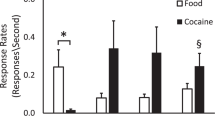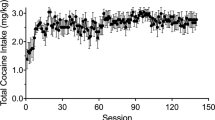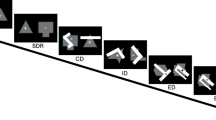Abstract
Cocaine abuse and dependence is a major public health problem that continues to challenge medication-based treatment. Buspirone (Buspar) is a clinically available, non-benzodiazepine anxiolytic medication that acts on both serotonin and dopamine systems. In recent preclinical studies, acute buspirone treatment reduced cocaine self-administration at doses that did not also decrease food-reinforced behavior in rhesus monkeys (Bergman et al, 2012). The present study evaluated the effectiveness of chronic buspirone treatment on self-administration of cocaine and food. Five adult rhesus monkeys (Macaca mulatta) were trained to self-administer cocaine and food during four 1-h daily sessions under a second-order schedule of reinforcement (FR2 [VR 16:S]). Buspirone (0.32 and 0.56 mg/kg/h) was administered intravenously through one lumen of a double-lumen catheter every 20 min for 23 h each day for 7–10 consecutive days. Each buspirone treatment period was followed by saline control treatment until drug- and food-maintained responding returned to baseline levels. Buspirone significantly reduced responding maintained by cocaine, and shifted the dose–effect curve downwards. Buspirone had minimal effects on food-maintained responding. In cocaine discrimination studies, buspirone (0.1–0.32 mg/kg, IM) did not antagonize the discriminative stimulus and rate-altering effects of cocaine in four of six monkeys. These findings indicate that buspirone selectively attenuates the reinforcing effects of cocaine in a nonhuman primate model of cocaine self-administration, and has variable effects on cocaine discrimination.
Similar content being viewed by others
Log in or create a free account to read this content
Gain free access to this article, as well as selected content from this journal and more on nature.com
or
References
Achat-Mendes C, Grundt P, Cao J, Platt DM, Newman AH, Spealman RD (2010). Dopamine D3 and D2 receptor mechanisms in the abuse-related behavioral effects of cocaine: studies with preferential antagonists in squirrel monkeys. J Pharmacol Exp Ther 334: 556–565.
Achat-Mendes C, Platt DM, Newman AH, Spealman RD (2009). The dopamine D3 receptor partial agonist CJB 090 inhibits the discriminative stimulus but not the reinforcing or priming effects of cocaine in squirrel monkeys. Psychopharmacology (Berl) 206: 73–84.
Acri JB, Carter SR, Alling K, Geter-Douglass B, Dijkstra D, Wikstrom H et al (1995). Assessment of cocaine-like discriminative stimulus effects of dopamine D3 receptor ligands. Eur J Pharmacol 281: R7–R9.
Balster RL (1990). Abuse potential of buspirone and related drugs. J Clin Psychopharmacol 10: 31S–37S.
Balster RL, Woolverton WL (1982). Intravenous buspirone self-administration in rhesus monkeys. J Clin Psychiatry 43: 34–37.
Beardsley PM, Sokoloff P, Balster RL, Schwartz JC (2001). The D3R partial agonist, BP 897, attenuates the discriminative stimulus effects of cocaine and D-amphetamine and is not self-administered. Behav Pharmacol 12: 1–11.
Bergman J, Roof RA, Furman CA, Conroy JL, Mello NK, Sibley DR et al (2012). Modification of cocaine self-administration by buspirone (Buspar®): potential involvement of D3 and D4 dopamine receptors. Int J Neuropsychopharmacol 25: 1–14.
Butelman ER, Harris TJ, Kreek MJ (1999). Effects of E-2078, a stable dynorphin A(1–8) analog, on sedation and serum prolactin levels in rhesus monkeys. Psychopharmacology (Berl) 147: 73–80.
Caine SB, Koob GF (1993). Modulation of cocaine self-administration in the rat through D-3 dopamine receptors. Science 260: 1814–1816.
Caine SB, Koob GF (1995). Pretreatment with the dopamine agonist 7-OH-DPAT shifts the cocaine self-administration dose-effect function to the left under different schedules in the rat. Behav Pharmacol 6: 333–347.
Callahan PM, Cunningham KA (1997). Modulation of the discriminative stimulus properties of cocaine: comparison of the effects of fluoxetine with 5-HT1A and 5-HT1B receptor agonists. Neuropharmacology 36: 373–381.
Cinciripini PM, Lapitsky L, Seay S, Wallfisch A, Meyer WJI, Van Vunakis H (1995). A placebo-controlled evaluation of the effects of buspirone on smoking cessation: differences between high- and low-anxiety smokers. J Clin Pharmacol 15: 182–191.
Claytor R, Lile JA, Nader MA (2006). The effects of eticlopride and the selective D3-antagonist PNU 99194-A on food- and cocaine-maintained responding in rhesus monkeys. Pharmacol Biochem Behav 83: 456–464.
Cole JO (1982). New anxiety agents. Psychopharmacol Bull 18: 45–46.
Di Ciano P (2008). Drug seeking under a second-order schedule of reinforcement depends on dopamine D3 receptors in the baslolateral amygdala. Behav Neurosci 122: 129–139.
Dockens RC, Salazar DE, Fulmore IE, Wehling M, Arnold ME, Croop R (2006). Pharmacokinetics of a newly identified active metabolite of buspirone after administration of buspirone over its therapeutic dose range. J Clin Pharmacol 46: 1308–1312.
Elkashef A, Vocci FJ, Huestis M, Haney M, Budney A, Gruber A et al (2008). Marijuana neurobiology and treatment. Subst Abus 29: 17–29.
Fivel PA (2011). Computer-controlled drug doses for IV drug self-administration. Exp Clin Psychopharmacol 19: 131–133.
Gal K, Gyertyan I (2003). Targeting the dopamine D3 receptor cannot influence continuous reinforcement cocaine self-administration in rats. Brain Res Bull 61: 595–601.
Gammans RE, Mayol RF, LaBudde JA (1986). Metabolism and disposition of buspirone. Am J Med 80: 41–51.
Gold LH, Balster RL (1992). Effects of buspirone and gepirone on i.v. cocaine self-administration in rhesus monkeys. Psychopharmacology (Berl) 108: 289–294.
Goldberg HL (1984). Buspirone hydrochloride: a unique new anxiolytic agent. Pharmacokinetics, clinical pharmacology, abuse potential and clinical efficacy. Pharmacotherapy 4: 315–324.
Griffith JD, Jasinski DR, Casten GP, McKinney GR (1986). Investigation of the abuse liability of buspirone in alcohol-dependent patients. Am J Med 80: 30–35.
Griffiths RR, Lamb RJ, Sannerud CA, Ator NA, Brady JV (1991). Self-injection of barbiturates, benzodiazepines and other sedative-anxiolytics in baboons. Psychopharmacology (Berl) 103: 154–161.
Gyertyan I, Kiss B, Gal K, Laszlovszky I, Horvath A, Gemesi LI et al (2007). Effects of RGH-237 [N-{4-[4-(3-aminocarbonyl-phenyl)-piperazin-1-yl]-butyl}-4-bromo-benzamide], an orally active, selective dopamine D(3) receptor partial agonist in animal models of cocaine abuse. J Pharmacol Exp Ther 320: 1268–1278.
Haney M, Spealman R (2008). Controversies in translational research: drug self-administration. Psychopharmacology (Berl) 199: 403–419.
Heidbreder CA, Gardner EL, Xi Z-X, Thanos PK, Mugnaini M, Hagan JJ et al (2005). The role of central dopamine D3 receptors in drug addiciton: a review of pharmacological evidence. Brain Res Rev 49: 77–105.
Heidbreder CA, Newman AH (2010). Current perspectives on selective dopamine D3 receptor antagonists as pharmacotherapeutics for addictions and related disorders. Ann NY Acad Sci 1187: 4–34.
Henningfield JE, Fant RV, Buchhalter AR, Stitzer ML (2005). Pharmacotherapy for nicotine dependence. CA Cancer J Clin 55: 281–299, quiz 322-283, 325.
Herin DV, Rush CR, Grabowski J (2010). Agonist-like pharmacotherapy for stimulant dependence: preclinical, human laboratory, and clinical studies. Ann NY Acad Sci.
Hilleman DE, Mohiuddin SM, Del Core MG, Sketch MH (1992). Effect of buspirone on withdrawal symptoms associated with smoking cessation. Arch Intern Med 152: 350–352.
Homberg JR, Arends B, Wardeh G, Raaso HS, Schoffelmeer AN, de Vries TJ (2004). Individual differences in the effects of serotonergic anxiolytic drugs on the motivation to self-administer cocaine. Neuroscience 128: 121–130.
ILAR-NRC (1996) Guide for the Care and Use of Laboratory Animals. National Academy Press: Washington, DC, pp 125.
Kleven MS, Barret-Grevoz C, Bruins-Slot L, Newman-Tancredi A (2005). Novel antipsychotic agents with 5-HT1A agonist properties: role of 5-HT1A receptor activation in attenuation of catalepsy induction in rats. Neuropharmacology 49: 135–143.
Koetzner L, Riley AL, Glowa JR (1996). Discriminative stimulus effects of dopaminergic agents in rhesus monkeys. Pharmacol Biochem Behav 54: 517–523.
Kula NS, Baldessarini RJ, Kebabian JW, Neumeyer JL (1994). S-(+)-aporphines are not selective for human D3 dopamine receptors. Cell Mol Neurobiol 14: 185–191.
Lamas X, Negus SS, Nader MA, Mello NK (1996). Effects of the putative dopamine D3 receptor agonist 7-OH-DPAT in rhesus monkeys trained to discriminate cocaine from saline. Psychopharmacology (Berl) 124: 306–314.
Le Foll B, Goldberg SR, Sokoloff P (2005). D3 receptor and drug dependence: effects on reward or beyond? Neuropharmacology 49: 525–541.
Le Foll B, Schwartz J-C, Sokoloff P (2000). Dopoamine D3 receptor agents as potential new medications for drug addiction. Eur Psychiatry 15: 140–146.
Line SW (1987). Environmental enrichment for laboratory primates. J Am Vet Med Assoc 190: 854–859.
Mahmood I, Sahajwalla C (1999). Clinical Pharmacokinetics and pharmacodynamics of buspirone, an anxiolytic drug. Clin Pharmacokinet 36: 277–287.
Mandrioli R, Mercolini L, Raggi MA (2010). Metabolism of benzodiazepine and non-benzodiazepine anxiolytic-hypnotic drugs: an analytical point of view. Curr Drug Metab 11: 815–829.
Marathe PH, Shen F, Markham P, Greene DS (1999). Pharmacokinetics of buspirone followoing oral administration to rhesus monkeys. J Pharm Pharmacol 51: 601–607.
Martelle JL, Claytor R, Ross JT, Reboussin BA, Newman AH, Nader MA (2007). Effects of two novel D3-selective compounds, NGB 2904 [N-(4-(4-(2, 3-dichlorophenyl) piperazin-1-yl) butyl)-9H-fluorene-2-carboxamide] and CJB 090 [N-(4-(4-(2, 3-dichlorophenyl) piperazin-1-yl) butyl)-4-(pyridin-2-yl) benzamide], on the reinforcing and discriminative stimulus effects of cocaine in rhesus monkeys. J Pharmacol Exp Ther 321: 573–582.
McRae-Clark AL, Carter RE, Killeen TK, Carpenter MJ, Wahlquist AE, Simpson SA et al (2009). A placebo-controlled trial of buspirone for the treatment of marijuana dependence. Drug Alc Depend 105: 132–138.
Mello NK (2005). Marian W Fischman memorial lecture (2004). Evaluation of drug abuse treatment medications: concordance between clinical and preclinical studies. In: Dewey WL (ed). Problems of Drug Dependence 2004: Proceedings of the 66th Annual Scientific Meeting, The College on Problems of Drug Dependence, Inc. US Department of Health and Human Services, National Institutes of Health: Bethesda, MD, pp 82–104.
Mello NK, Negus SS (1996). Preclinical evaluation of pharmacotherapies for treatment of cocaine and opiate abuse using drug self-administration procedures. Neuropsychopharmacology 14: 375–424.
Mello NK, Negus SS (2007). Effects of d-amphetamine and buprenorphine combinations on speedball (cocaine+heroin) self-administration by rhesus monkeys. Neuropsychopharmacology 32: 1985–1994.
Mello NK, Negus SS, Lukas SE, Mendelson JH, Sholar JW, Drieze JM (1995). A primate model of polydrug abuse: cocaine and heron combinations. J Pharmacol Exp Ther 274: 1325–1337.
Muller CP, Carey RJ, Huston JP, De Souza Silva MA (2007). Serotonin and psychostimulant addiction: focus on 5-HT1A-receptors. Prog Neurobiol 81: 133–178.
Nader MA, Barrett JE (1990). Effects of chlordiazepoxide, buspirone, and serotonin receptor agonists and antagonists on responses of squirrel monkeys maintained under second-order schedules of intramuscular cocaine injection or food presentation. Drug Dev Res 20: 5–17.
Nader MA, Green KL, Luedtke RR, Mach RH (1999). The effects of benzamide analogues on cocaine self-administration in rhesus monkeys. Psychopharmacology (Berl) 147: 143–152.
Nader MA, Mach RH (1996). Self-administration of the dopamine D3 agonist 7-OH-DPAT in rhesus monkeys is modified by previous cocaine exposure. Psychopharmacology (Berl) 125: 13–22.
Negus SS, Mello NK (2003). Effects of chronic d-amphetamine treatment on cocaine- and food-maintained responding under a second-order schedule in rhesus monkeys. Drug Alc Depend 70: 39–52.
Newman AH, Blaylock BL, Nader MA, Bergman J, Sibley DR, Skolnick P (2012). Medication discovery for addiction: translating the dopamine D3 receptor hypothesis. Biochem Pharmacol 84: 882–890.
Newman AH, Grundt P, Nader MA (2005). Dopamine D3 receptor partial agonists and antagonists as potential drug abuse therapeutic agents. J Med Chem 48: 3663–3679.
Newman-Tancredi A, Gavaudan S, Conte C, Chaput C, Touzard M, Verriele L et al (1998). Agonist and antagonist actions of antipsychotic agents at 5-HT1A receptors: a [35S]GTPgammaS binding study. Eur J Pharmacol 355: 245–256.
Peng X-Q, Ashby CR, Spiller K, Li X, Li J, Thomasson N et al (2009). The preferential dopamine D3 receptor antagonist S33138 inhibits cocaine reward and cocaine-triggered relapse to drug-seeking behavior in rats. Neuropharmacology 56: 752–760.
Pilla M, Perachon S, Sautel F, Garrido F, Mann A, Wermuth CG et al (1999). Selective inhibition of cocaine-seeking behaviour by a partial dopamine D3 receptor agonist. Nature 400: 371–375.
Prinssen EPM, Colpaert FC, Koek W (2002). 5-HT1A receptor activation and anti-cataleptic effects: high-efficacy agonists maximally inhibit haloperidol-induced catalepsy. Eur J Pharmacol 453: 217–221.
Prinssen EPM, Koek W, Colpaert FC, Kleven MS (2000). Repeated treatment with 8-OH-DPAT induces tolerance to its ability to produce the 5-HT1A behavioural syndrome, but not to its ability to attenuate haloperidol-induced catalepsy. Behav Pharmacol 11: 299–305.
Rapoza D (1993). Buspirone fails to affect the discriminative stimulus effects of cocaine. Pharmacol Biochem Behav 45: 179–183.
Rijnders HJ, Slangen JL (1993). The discriminative stimulus properties of buspirone involve dopamine-2 receptor antagonist activity. Psychopharmacology (Berl) 111: 55–61.
Rush CR, Critchfield TS, Troisi JR, Griffiths RR (1995). Discriminative stimulus effects of diazepam and buspirone in normal volunteers. J Exp Anal Behav 63: 277.
Sheskin DJ (2000) Handbook of Parametric and Nonparametric Statistical Procedures. 2nd edn. Chapman and Hall: Boca Raton, FL.
Song R, Yang R-F, Wu N, Su R-B, Li J, Peng X-Q et al (2012). YQ14: a novel dopamine D3 receptor antagonist that inhibits cocaine self-administration in rats and mice, but not in D3 receptor-knockout mice. Addict Biol 17: 259–273.
Spealman RD (1996). Dopamine D3 receptor agonists partially reproduce the discriminative stimulus effects of cocaine in squirrel monkeys. J Pharmacol Exp Ther 278: 1128–1137.
Tallman F, Primus RJ, Brodbeck R, Cornfield L, Meade R, Woodruff K et al (1997). I. NGD 94-1: identification of a novel, high-affinity antagonist at the human dopamine D4 receptor. J Pharmacol Exp Ther 282: 1011–1019.
Weinstein AM, Gorelick DA (2011). Pharmacological treatment of cannabis dependence. Curr Pharm Des 17: 1351–1358.
West R, Hajek P, McNeil A (1991). Effect of buspirone on cigarette withdrawal symptoms and short-term abstinence rates in a smokers clinic. Psychopharmacology (Berl) 104: 91–96.
Winhusen T, Brady KT, Stitzer M, Woody G, Lindblad R, Kropp F et al (2012). Evaluation of buspirone for relapse-prevention in adults with cocaine dependence: an efficacy trial conducted in the real world. Contemp Clin Trials.
Wong H, Dockens RC, Pajor L, Yeola S, Grace JEJ, Stark AD et al (2007). 6-Hydroxybuspirone is a major active metabolite of buspirone: assessment of pharmacokinetics and 5-hydroxytryptamine 1A receptor occupancy in rats. Drug Metab Dispos 35: 1387–1392.
Xi Z-X, Gardner EL (2007). Pharmacological actions of NGB 2904, a selective dopamine D3 receptor antagonist, in animal models of drug addiction. CNS Drug Rev 13: 240–259.
Xi Z-X, Gilbert JG, Pak AC, Ashby CR, Heidbreder CA, Gardner EL (2005). Selective dopamine D3 receptor antagonism by SB-277011A attenuates cocaine reinforcement as assessed by progressive-ratio and variable-cost-vriable-payoff fixed-ratio cocaine self-adminlstration in rats. Eur J Neurosci 21: 3427–3438.
Xi Z-X, Newman AH, Gilbert JG, Pak AC, Peng X-Q, Ashby CR et al (2006). The novel dopamine D3 receptor antagonist NGB 2904 inhibits coaine's rewarding effects and cocaine-induced reinstatement of drug-seeking behaivor in rats. Neuropsychopharmacology 31: 1393–1405.
Acknowledgements
This work was supported in part by grant number R01-DA002519 and R01-DA026892 (NK Mello, PI) from the National Institute on Drug Abuse, NIH. We thank Meredith Mahnke, Sherilyn Pattel, and Olga Smirnova for excellent technical assistance.
Author information
Authors and Affiliations
Corresponding author
Ethics declarations
Competing interests
The authors declare no conflict of interest.
Additional information
Preliminary data were reported at the 2011 meeting of the American College of Neuropsychopharmacology.
Rights and permissions
About this article
Cite this article
Mello, N., Fivel, P., Kohut, S. et al. Effects of Chronic Buspirone Treatment on Cocaine Self-Administration. Neuropsychopharmacol 38, 455–467 (2013). https://doi.org/10.1038/npp.2012.202
Received:
Revised:
Accepted:
Published:
Issue date:
DOI: https://doi.org/10.1038/npp.2012.202
Keywords
This article is cited by
-
Improving translation of animal models of addiction and relapse by reverse translation
Nature Reviews Neuroscience (2020)
-
The effects of buspirone on occupancy of dopamine receptors and the rat gambling task
Psychopharmacology (2017)
-
Occupancy of Dopamine D3 and D2 Receptors by Buspirone: A [11C]-(+)-PHNO PET Study in Humans
Neuropsychopharmacology (2016)
-
Effects of buspirone and the dopamine D3 receptor compound PG619 on cocaine and methamphetamine self-administration in rhesus monkeys using a food-drug choice paradigm
Psychopharmacology (2015)
-
Effects of Chronic Varenicline Treatment on Nicotine, Cocaine, and Concurrent Nicotine+Cocaine Self-Administration
Neuropsychopharmacology (2014)



